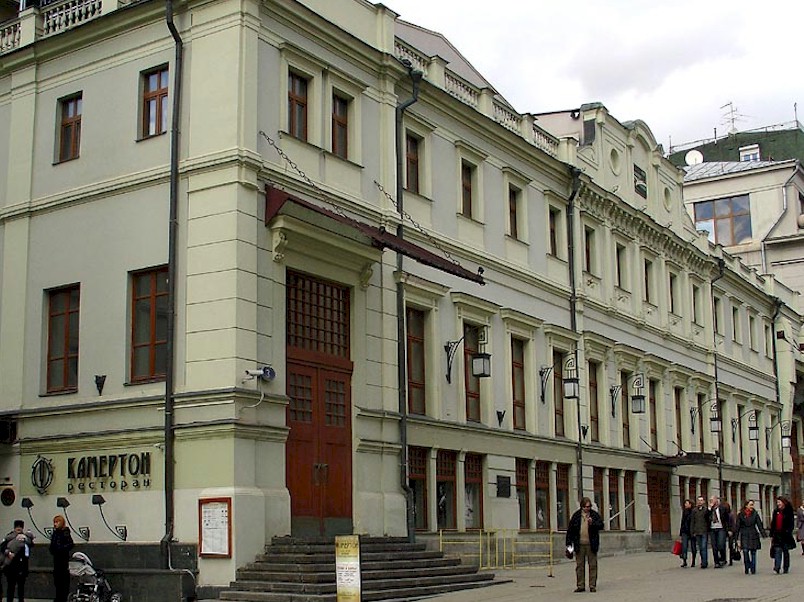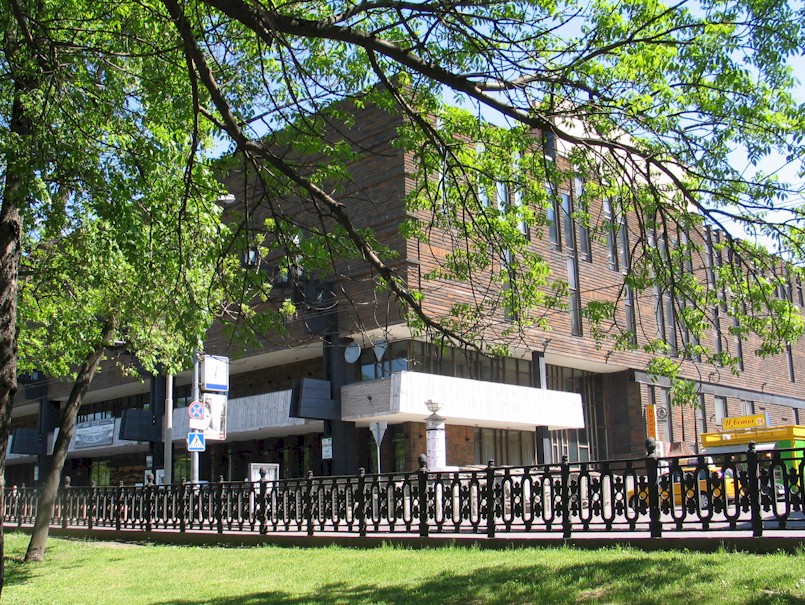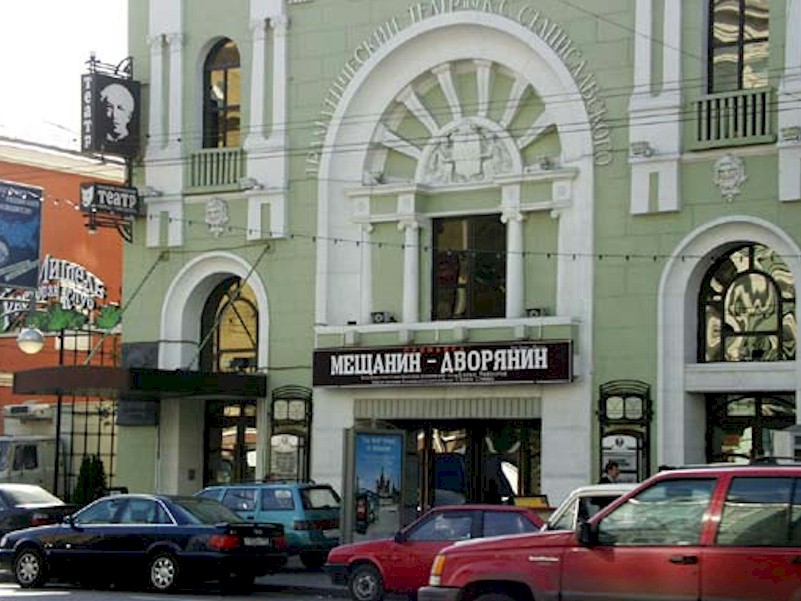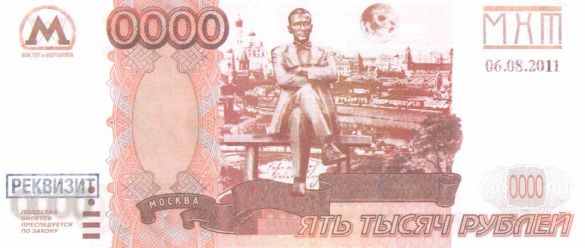The Moscow Art Theatre MKhAT
English > Locations > The Moscow Art Theatre MKhAT
The Moscow Art Theatre MKhAT still exists. In fact, there are even two theatres with this name in Moscow today. Both of which have The Master and Margarita on the repertoir. At the Gorky Art Theatre, the piece, directed by Valery Belyakovich, is on the repertoire since April 21, 2009. At the Chekhov Art Theatre, the piece, directed by the Hungarian János Szász, is on the repertoire since September 7, 2011.
The Chekhov Moscow Art Theatre
The repertoire theatre Московский Художественный академический театр (МХАТ) [Moskovsky Khudozhestvenny Akademichkiy Teatr] (MKhAT) or Moscow Art Theatre played a prominent role in Bulgakov’s life.
This theatre was established in 1897 by the famous Constantin Stanislavsky (1863-1938), real name Constantin Sergeevich Alekseev, and Vladimir Ivanovich Nemirovitch-Danshenko(1859-1943). Their ideas would introduce very modern concepts for theatre and they are considered as the founding fathers of the modern theatre, even far beyond the Russian borders. Their ensemble theatre rebeled against the heavily stylized theatre of the 19th century with its strongly realistic oriented way of acting and producing. Their first success was their fifth production, The Seagull by Anton Pavlovich Chekhov (1860-1904). By the way, the MKhAT's logo is, still today, a seagull.
As a theatre director, Stanislavsky focused on the complete harmony and coordination of all phases of a theater play's production process. His production of Chekhov's plays, in which he tried to leave out rhetorical clichés and to focus on the emotions and the complex philosophy of the characters, did not pass unnoticed. He forced his actors to identify themselves with the inner life of the characters, he thought that a natural use of body and voice were very important. His training method, known as the Stanislavsky method or method acting created a furore throughout the world and was taken over by the famous Actors' Studio of Lee Strasberg (1901-1982) in New York City.
In 1926, the Moscow Art Theatre produced Bulgakov's play The Days of the Turbins, based on his novel The White Guard. The critics were furious because Bulgakov portrayed the White officers with much sympathy, but the public loved it, and so did Joseph Stalin (1878-1953). The sets and the costumes were designed by Ilia Yakovlevich Sudakov (1890-1969), following the usual realistic standards of the MKhAT. Since 1943, the MKhAT has a famous theatre school which, since 1922, got a branch in the United States with the Stanislavsky Summer School in Cambridge, Massachusetts.
The Gorky Moscow Art Theatre
In good Russian tradition - look at what happened to the Bulgakov house - there was a long internal conflict at the Moscow Art Theatre MKhAT which spilled over into the newspapers, and the Kremlin decided in May 1987 to split up the theatre. Director Oleg Nikolaevich Efremov (1927-2000) remained as head of one half of the MKhAT, while actress Tatiana Vasilyevna Dronina (°1933) took charge of the other. The split quickly turned ideological, with the first MKhAT naming itself Chekhov Moscow Art Theatre and the second to be called Gorky Moscow Art Theatre. The Chekhov MKhAT is situated in the original theatre building at Kamergersky pereulok, which was designed in 1902 by the famous modern architect, Franz Osipovich Shekhtel (1859-1926), who also had designed the house in which Bulgakov situated the hospital of doctor Stravinsky. The Gorky MKhAT is in a huge modern building at Tverskoy Bulvar, just across the Herzen house, which was the prototype of the writers’ house Griboedov's.
The Stanislavsky Theatre
Another theatre in Moscow related to Constantin Stanislavsky was the Московский драматический театр имени К.С. Станиславского [Moskovsky dramatichesky theatr imeni K.S. Stanislavskogo] or Moscow drama theatre K.S.Stanislavsky. It's a smaller theatre on Tverskaya ulitsa, right between the two MKhAT's. It exists since 1935 and was created by Stanislavsky as a studio. The last three years of his life he trained actors there.
The Stanislavsky theatre also presented regular performances of The Master and Margarita, but it became embroiled in a series of conflicts and turbulences.
In 2008, Aleksander Galibin, the actor who played the role of the master in Vladimir Bortko's TV-series Master i Margarita from 2005 became the artistic director of the theatre. In June 2011 he got dismissed and replaced by Valery Belyakovich, who was at the same time directing adaptations of The Master and Margarita for other Moscow theatres like the South-West Theatre, the Arbat Theatre and the Gorky Art Theatre.
In 2013, the Department of Culture in Moscow ran a competition for the post of artistic director. The winner was Boris Yuryevich Yukhananov (°1957).
Yukhananov carried out a full-scale reconstruction of the ancient interior of the building, creating a new, multi-functional platform not only for theatre, but exhibitions, lectures and performance art. On January 26, 2015, the theatre re-opened as the Электротеатр Станиславский [Elektroteatr Stanislavsky] or Elektro Stanislavsky Theatre.
Московский Художественный академический театр имени
А. П. Чехова
(Chekhov MKhAT)
Kamergersky pereulok no. 3
Ticket desk: daily 12.00-19.00.
Tickets: about 50 roubles (1,25 euro).
Metro: Театральная (Teatralnaya) - Охотный ряд (Ohotniy ryad)
Московский Художественный академический театр имени
М. Горького
(Gorky MKhAT)
Tverskoy Bulvar no. 22
Ticket desk: Mon-Sat 12.00-15.00, 16.00-19.00.
Tickets: from 50 to 500 roubles (from 1,25 to 12,50 euro).
Metro: Пушкинская (Pushkinskaya), Тверская (Tverskaya), Чеховская (Chekhovskaya)
Электротеатр Станиславский
(Elektro Stanislavsky Theatre)
Tverskaya ulitsa no. 23
Ticket desk: daily12.00-15.00, 16.00-18.00.
Tickets: from 100 to 1.000 roubles (from 2,50 to 25,00 euro).
Metro: Пушкинская (Pushkinskaya), Тверская (Tverskaya), Чеховская (Chekhovskaya)
Share this page |
locations
The Master and Margarita
In September 2011, the Moscow Art Theatre started the new theatre season with an adaptation of The Master and Margarita directed by the Hungarian Janos Szasz. The production featured 36 named characters plus an additional cast of 30 extras. Designer Nikolai Smirnov made a huge underground world where the action of the novel was updated to the present. Instead of events taking place on Moscow streets, they unfold in the cavernous tunnels of the local metro.
The money-tossing scene in Woland’s show was handled nicely. All of a sudden the air above the audience was filled with fluttering orange pieces of paper that looked suspiciously like 5,000 ruble notes as they descended. The people in the theatre turned their gaze away from the stage and tried to spear one of those little bills, just as it happened in the novel.
Moscow map

Have a look at the most important places from the novel at a single glance on a clickable map of Moscow.



